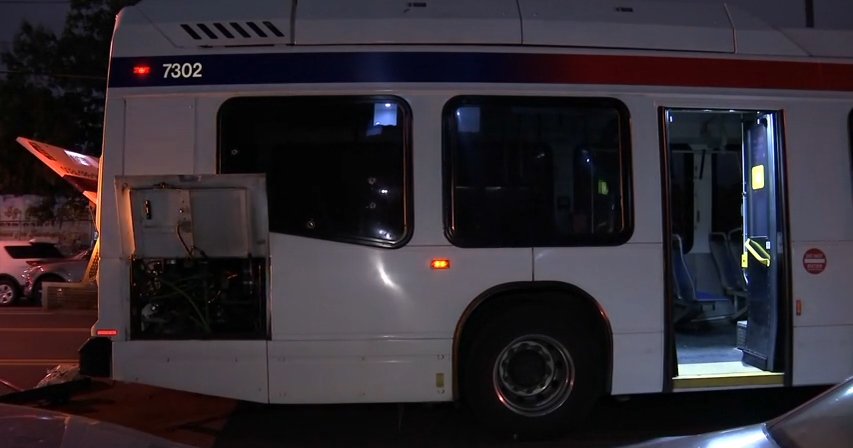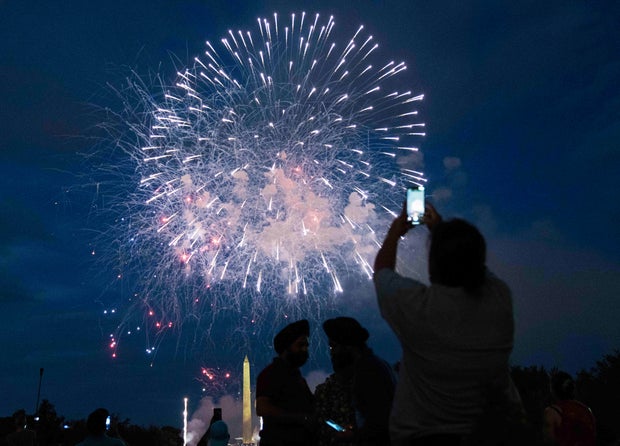CBS News
Map shows states where fireworks are legal or illegal on July 4, 2024

Fireworks have become a staple of July Fourth celebrations across the United States, where towns and cities often host professional shows to mark the occasion each year. In some areas, smaller displays of less powerful fireworks pop up at private holiday parties. For people wondering where fireworks are legal — and where they’re illegal — nationwide, here’s what to know.
Full list of U.S. states where some fireworks are legal
The U.S. Consumer Product Safety Commission has banned several types of fireworks — like M-80s, cherry bombs and anything else that contains more than 50 milligrams of pyrotechnic material — at the federal level, but state and local regulations can be more complicated. To varying degrees, certain types of fireworks are legal in 49 states, plus Washington, D.C.
Here’s the full list:
- Alabama
- Alaska
- Arizona
- Arkansas
- California
- Colorado
- Connecticut
- Delaware
- Florida
- Georgia
- Hawaii
- Idaho
- Illinois
- Indiana
- Iowa
- Kansas
- Kentucky
- Louisiana
- Maine
- Maryland
- Michigan
- Minnesota
- Mississippi
- Missouri
- Montana
- Nebraska
- Nevada
- New Hampshire
- New Jersey
- New Mexico
- New York
- North Carolina
- North Dakota
- Ohio
- Oklahoma
- Oregon
- Pennsylvania
- Rhode Island
- South Carolina
- Tennessee
- Texas
- Utah
- Vermont
- Virginia
- Washington
- Washington, D.C.
- West Virginia
- Wisconsin
- Wyoming
The one U.S. state where all private fireworks are illegal
Massachusetts is the only state in the U.S. where it is illegal to sell, use or otherwise possess fireworks of any kind as a private citizen. Many communities across the state host public fireworks displays at their July Fourth celebrations. But without a license and permit, the statewide law prohibits fireworks of all kinds, including sparklers, firecrackers and any other comparable device that’s been designed to produce “a visible or audible effect,” according to the state government.
The ban has existed since 1943, when state legislators amended an earlier set of statutes that previously allowed civilians to buy, sell and use certain kinds of fireworks for displays. When they enacted the fireworks ban, it was among an overhaul of measures enacted in response to World War II, some of which were billed as “emergency” orders meant specifically to remain effective as long as there was a potential enemy threat. But the the consumer fireworks law stayed in place after the war.
Despite periodic calls from within Massachusetts to lift the ban, officials say it continues to be necessary and have ramped up enforcement in recent years because illegal fireworks are prevalent. Between 2013 and 2022, Massachusetts fire departments reported almost 1,000 fires linked to illegal fireworks displays, in addition to 47 injuries — the majority to firefighters — and $2.5 million in damages, according to the state.
Minh Connors/The Washington Post via Getty Images
States where some fireworks are legal but many are restricted
Numerous states and Washington, D.C., restrict the sale, possession and use of consumer fireworks, even though professional fireworks displays are allowed with the appropriate licenses and permits. Those states are:
- Arizona
- California
- Colorado
- Connecticut
- Delaware
- Idaho
- Illinois
- Maryland
- Minnesota
- New Jersey
- New York
- North Carolina
- Oregon
- Rhode Island
- Vermont
- Virginia
- Washington, D.C.
- Wisconsin
Illinois and Vermont have stricter laws than the rest of the U.S. In those states, only sparklers and “novelty” smoke devices are up for sale to the general public. A “novelty” device is one that contains “small amounts of pyrotechnic and/or explosive composition” but does not technically meet requirements to be considered a consumer firework, according to the American Pyrotechnic Association.
In Illinois, novelties include snakes, glow worm pellets, smoke devices, party poppers, snappers, trick matches, and “other devices in which paper or plastic caps containing twenty-five hundredths grains or less of explosive compound are used,” per the state law banning most consumer fireworks.
The laws are similar in Vermont, where certain sparklers and novelty devices are allowed, provided that the sparklers contain 20 grams or less of pyrotechnic materials and the novelties contain 0.25 grains or less of explosive mixture, according to the Office of the State Fire Marshal.
States that let counties determine fireworks laws
Hawaii, Nevada and Wyoming allow counties to determine whether fireworks are legal or not within their individual jurisdictions, as well as which kinds of fireworks are allowed and exactly when and where people can buy, sell and use them.
In Hawaii, concerns over public safety prompted legislators in 2010 to pass a law that gave counties the authority to set stricter regulations for consumer fireworks than the ones established at the state level. It allowed, for instance, the City and County of Honolulu to broadly prohibit the sale, possession and use of all consumer fireworks except fire crackers — which can be obtained with a permit. But the ordinance doesn’t apply to other counties.
Similar laws have been passed by state legislatures in Nevada and Wyoming to give local officials control over fireworks in their areas. In those states, consumer fireworks may be legal in one county and banned in another, and some counties restrict buying, selling and using fireworks to specific times on designated days of the year.
Even when consumer fireworks are generally regulated by the state, people may find themselves in a town or city in Arizona, California, Colorado, Maryland, Nevada or Ohio that has more stringent fireworks laws than its neighbors. And, in places like Illinois, setting off fireworks is only allowed in counties that have passed an ordinance to permit it, including on private property.
What are non-aerial and non-explosive fireworks?
Most of the states where some but not all fireworks are legally accessible to civilians limit what’s allowed to non-aerial and non-explosive fireworks only. Sometimes called “safe and sane” fireworks, these typically refer to devices that don’t explode or fly. Because they contain lower amounts of combustible material than other fireworks, officials say they are also less likely to cause injuries or damage to property.
In wildfire-prone California, purchasing fireworks is illegal unless their packaging explicitly bears a “safe and sane” seal. A fireworks education site operated by the California fire marshal’s office lists sky rockets, bottle rockets, Roman candles, aerial shells and firecrackers as a few examples of fireworks that have been banned statewide in accordance with “safe and sane” standards, along with “other fireworks that explode, go into the air, or move on the ground in an uncontrollable manner.”
A growing number of California counties have outlawed fireworks altogether. Violators could faces fines and or jail time.
Why do some states ban certain fireworks?
Most states that place restrictions for civilians on the sale, possession and use of fireworks say the risks of injuries and property damages are their main reasons for doing so. In a number of those states, officials also cite the increased likelihood of wildfires sparking and potentially spreading in an area where fireworks have been set off.
The U.S. Consumer Product Safety Commission said it received reports of eight deaths and an estimated 9,700 injuries related to fireworks in 2023 alone. Of the eight deaths, five were associated with fireworks misuse, two with device malfunction and one was unknown.
How to report illegal fireworks
States and counties across the country encourage people to report any instances where they suspect illegal fireworks are involved, and many ask their residents to file those reports to their local fire departments or law enforcement agencies. People can also report illegal fireworks activity to a hotline at the U.S. Bureau of Alcohol, Tobacco and Firearms, which is responsible for regulating all explosives, including fireworks.
CBS News
Former New York Gov. David Paterson, stepson attacked while walking in New York City

NEW YORK — Former New York Gov. David Paterson and his stepson were attacked in New York City on Friday night, authorities said.
The incident occurred just before 9 p.m. on Second Avenue near East 96th Street on the Upper East Side, according to the New York City Police Department.
Police said officers were sent to the scene after an assault was reported. When officers arrived, police say they found a 20-year-old man suffering from facial injuries and a 70-year-old man who had head pain. Both victims were taken to a local hospital in stable condition.
In a statement, a spokesperson for the former governor said the two were attacked while “taking a walk around the block near their home by some individuals that had a previous interaction with his stepson.”
The spokesperson said that they were injured “but were able to fight off their attackers.”
Both were taken to Cornell Hospital “as a precaution,” he added.
Police said no arrests have been made and the investigation is ongoing.
The 70-year-old Paterson, a Democrat, served as governor from 2008 to 2010, stepping into the post after the resignation of Eliot Spitzer following his prostitution scandal. He made history at the time as the state’s first-ever Black and legally blind governor.
CBS News
10/4: CBS Evening News – CBS News

Watch CBS News
Be the first to know
Get browser notifications for breaking news, live events, and exclusive reporting.
CBS News
Teen critically wounded in shooting on Philadelphia bus; one person in custody

A 17-year-old boy was critically injured and a person is in custody after a gunman opened fire on a SEPTA bus in North Philadelphia Friday evening, police said.
At around 6:15 p.m., Philadelphia police were notified about a shooting on a SEPTA bus traveling on Allegheny Avenue near 3rd and 4th streets in North Philadelphia, Inspector D F Pace told CBS News Philadelphia.
There were an estimated 30 people on the bus at the time of the shooting, Pace said, but only the 17-year-old boy was believed to have been shot. Investigators said they believe it was a targeted attack on the teenager and that he was shot in the back of the bus at close range.
According to Pace, the SEPTA bus driver alerted a control center about the shooting, which then relayed the message to Philadelphia police, who responded to the scene shortly.
Officers arrived at the scene and found at least one spent shell casing and blood on the bus, but no shooting victim, Pace said. Investigators later discovered the 17-year-old had been taken to Temple University Hospital where he is said to be in critical condition, according to police.
CBS Philadelphia
Through their preliminary investigation, police learned those involved in the SEPTA shooting may have fled in a silver-colored Kia.
Authorities then found a car matching the description of the Kia speeding in the area and a pursuit began, Pace said. Police got help from a PPD helicopter as they followed the Kia, which ended up crashing at 5th and Greenwood streets in East Mount Airy. Pace said the Kia crashed into a parked car.
The driver of the crashed car ran away but police were still able to take them into custody, Pace said.
Investigators believe there was a second person involved in the shooting who ran from the car before it crashed. Police said they believe this person escaped near Allegheny Avenue and 4th Street, leaving a coat behind.
According to Pace, police also found a gun and a group of spent shell casings believed to be involved in the shooting in the same area.
“It’s very possible that there may have been a shooting inside the bus and also shots fired from outside of the bus toward the bus,” Pace said, “We’re still trying to piece all that together at this time.”
This is an active investigation and police are reviewing surveillance footage from the SEPTA bus.









